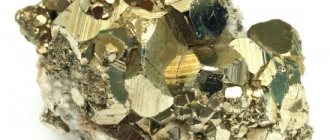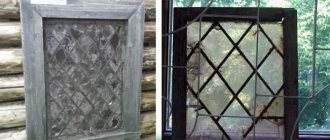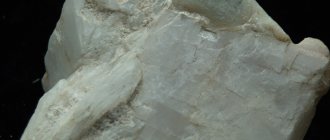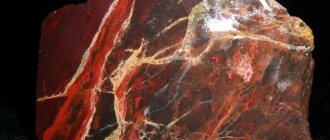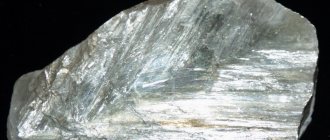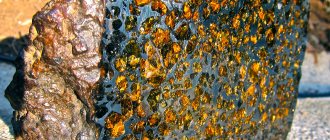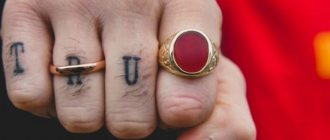Heliotrope is a mineral of the quartz group, colored dark green. Various impurities form red, yellow-brown spots on the surface. The origin of the name is related to the Greek words meaning “sun”, “turn”. In English - Heliotrope. The stone is also popularly called bloody, Stefanov, oriental jasper, bloody jasper, red agate.
History and origin
Heliotrope, which received other names for its specific appearance - “blood stone” and “blood jasper”, is of Asian origin. From Ancient India and Bukhara, it came to Europe about two thousand years ago, where it was revered as a gem associated with Christ and St. Stephen, who suffered execution by stoning.
Bloody Jasper
According to Middle Eastern and European legends, the characteristic red (from scarlet to dark speckled) spots with which this mineral is dotted are drops of the congealed blood of the crucified Christ. Thanks to this, heliotrope became the “trademark” of European mystics and theologians for many centuries.
Pectoral crosses with it are still popular among priests, both Catholic and Orthodox. Various items of church utensils were also often made from it.
History of the stone
Heliotrope has been known to mankind since time immemorial. We find the first mention of this stone in cuneiform tablets of Mesopotamia and Babylon. And the mineral was called the Babylonian stone for a long time. Pharaohs and the highest nobility of Egypt did not hesitate to wear heliotrope jewelry. Dark magicians used the dark power of the stone for rites and rituals.
At different times and in different countries, heliotrope was called differently. It received its current name from the ancient Greeks. It consists of 2 words: “helios” - sun and “trope” - turn. The meaning of the name “solstice” is now difficult to explain.
There are several versions of why the stone is named this way:
- The stone is capable of influencing the movement of celestial bodies (the version is weak and practically unprovable).
- The mineral can (during special rituals) change the weather.
- When immersed in water, the stone changes and “turns” the light of the sun’s rays. This version can be checked by any owner of heliotrope.
The mineral has other names:
- Bloodstone is called bloodstone in countries where English is spoken.
- It is called “bloody jasper” for its inclusions of red color.
- In many historical works the mineral is called eastern (oriental) or German jasper.
- For Christians, for a long time it was “Stephen’s Stone” - in honor of St. Stephen, whom a crowd of unbelievers stoned to death.
- Red or meat agate.
- Babylonian stone.
But no matter what they call heliotrope with its dark beauty, it has always been valued by people who needed strength, straightforwardness, and help in understanding the world and gaining knowledge.
Physicochemical characteristics
The hardness of the mineral is above average, up to 7 on the Mohs scale. It is a complex mineral, the basis of which is silicon oxide, but inclusions of other minerals, in particular chalcedony, can be found. The closest relative of heliotrope is quartz.
| Formula | SiO2 |
| Color | Dark green, greenish blue with bright red spots |
| Shine | Glass pale shine |
| Transparency | Opaque |
| Hardness | 6,5 — 7 |
| Cleavage | Absent |
| Kink | Uneven |
| Density | Up to 2.58–2.64 g/cm3 |
Ring “Amulet” heliotrope
Ring with an insert made of natural heliotrope stone. Bezel width 6mm.
PROPERTIES OF HELIOTROPE STONE HELIOTROPE The name heliotrope comes from the Greek words helios - sun and trope - turn. Other names for the mineral and its varieties: stephan stone, bloody jasper. Heliotrope is an opaque variety of chalcedony. The color of the stone is dark green with bright red stripes and spots, as well as with white inclusions. The shine is glassy. Hardness - 6.5-7.0; density - 2.5 g/cm3. Main deposits: Russia (Ural), Australia, Brazil, China, Central Asia, Egypt. Medicinal properties It is believed that heliotrope has the ability to stop bleeding and helps increase hemoglobin in the blood. The stone helps most strongly if worn in the form of bracelets on both hands. Magical properties Since ancient times, heliotrope has been considered one of the most important stones in magic and alchemy. Medieval sorcerers wore rings and bracelets with heliotrope when performing spells and in magical rituals, as it was believed that it enhanced the effect of the magic word and ritual. Alchemists, with the help of this stone, tried to penetrate the secrets of the Universe, using it as a conductor between man and the Cosmos. Other miraculous qualities were also attributed to him. Dante Alighieri in The Divine Comedy writes that heliotrope makes a person invisible and protects against the effects of poison. The owner of this stone has the ability to study foreign languages, philosophy, psychology, and medicine. However, it should be remembered that this mineral “honestly serves” only those people who have firmly chosen the direction of their professional activity, as well as those who are obsessed with their work and try to do everything to acquire and improve their professional skills. People who cannot concentrate on any one task should not wear this stone. Heliotrope does not tolerate the owner’s throwing and will harm him, attracting failures and even troubles. The stone helps hard workers achieve success in their work, makes them happy, but it drives away love luck (since it distracts a person from the love of work). Astrologers say that heliotrope is simultaneously associated with Saturn, the Moon and Venus, so it gives its owner the ability to influence other people, living and inanimate nature. It should be worn by Leos, Taurus and Cancers. Under no circumstances should Scorpio, Sagittarius and Aries have it. For the rest of the zodiac signs, this stone will be an ordinary decoration, since they are not interested in him. Talismans and amulets As a talisman, heliotrope brings happiness to the military, lawyers and representatives of the law - it helps to concentrate their attention, concentration, and develops tactical skills. This stone helps scientists and philosophers reach the highest intellectual level. As an ornamental stone, heliotrope was especially valued in cases where bright spots on a dark background could participate in the image, and was used for carving and decoration of church utensils and priestly clothing. The stone was known in Ancient Egypt and in one of the papyri it is glorified in the following expressions: there is no greater thing in the world, if someone has it with him, he will receive everything he asks for; it softens the anger of rulers and rulers and makes them believe everything that the owner of the stone says. Anyone who wears heliotrope, if he utters the name carved on it, will find all the doors open, and the stones of the walls crack and fall apart. According to the beliefs of the 12th century, heliotrope has the ability to change good weather and cause rain. In addition, it was believed that the stone stopped bleeding, provided the owner with long life and health, gave him the gift of prophecy and the ability to predict future events, glorified those to whom it was given, suppressed blood flow and neutralized poisons. One of these properties is mentioned by Dante in the Divine Comedy, saying that heliotrope protects against poison and makes the owner invisible. Giorgio Vasari, a biographer of Italian Renaissance artists, said that he once had a severe nosebleed, which the artist Luca Signorelli stopped by stroking a heliotrope amulet between Vasari's shoulder blades and then hanging the amulet around his neck. On the other side of the Atlantic, Indians used a heart-shaped heliotrope amulet to stop bleeding. The greatest effect was observed when the stone was immersed in cold water and then held in the right hand. The Spanish missionary to America, Bernardino de Sahagún, wrote that in 1574 he healed many Indians who were close to death from loss of blood due to the plague by giving them a piece of heliotrope to hold in their hand. The famous Robert Boyle in his Essays on the Origin and Properties of Gems (1672), not at all believing in the mysterious properties of gems, nevertheless says that one of his acquaintances suffered from nosebleeds, but got rid of them by wearing heliotrope around his neck, Boyle assumed, that the whole point is in the patient’s self-hypnosis, that the stone will help him.
Place of extraction
Currently, heliotrope deposits are being actively developed in the Urals and in the USA - the states of California and Wyoming. There is a small deposit in Bukhara (Uzbekistan). The stone is also mined in Australia, Namibia, Egypt, Armenia, China and India, although the richest and oldest Indian deposit of “blood jasper”, located in Calcutta, has already been exhausted.
Where and how is stone mined?
Nugget refers to volcanic rock that forms in lava voids. When a hot stream slowly flows down the mountain slopes, coming into contact with water, it cools down.
Geologists have discovered deposits of this nugget near ancient and active volcanoes. Until the 17th century, the gem was brought to the territory of the Russian Empire only from the East and was presented as a variety of jasper. For this reason, it was often called bloody jasper, a special stone of the East, or bloodstone.
Place of Birth
Most modern heliotrope deposits are located on the European continent, Central Asia, America, and Australia. Large deposits are found in the following countries:
- Egypt;
- Australia (near Kolkata);
- USA (in California);
- Canada (Wyoming);
- Brazil;
- Russia (only in the Urals).
Relatively recently, the mineral was discovered on the island of Rum, which belongs to Scotland.
Varieties and colors
The term “heliotrope” is more jewelry than chemical. This word can refer to a wide range of stones that are similar in appearance and physical properties, but different in chemical nature. A specific instance of a processed stone may be more related to quartz, or perhaps to chalcedony or jasper, of which it is considered a brother due to its appearance.
The stone looks quite beautiful. It is recognized by its greenish or bluish main color with numerous scarlet, red, burgundy and orange patches, located randomly. They may appear as spots, blotches or streaks. Darker inclusions of hematite are also acceptable.
Incredibly beautiful heliotrope pattern
“Bloody jasper” with yellow splashes is called plasma.
There is no clear classification of heliotropes according to color scheme. Like jasper, with which it is often confused, the gem can play with any colors, but among them there is always green or ultramarine and red. Shades of the main color can be very diverse - from grayish swamp to deep blue.
This is unusual: when looking at some faceted heliotropes, an association arises with photographs of distant galaxies taken through electronic telescopes. Clusters of scarlet, orange and yellow dots on a greenish-blue background turn out to be surprisingly similar in appearance to photographs of stellar nebulae.
This gem is opaque and, after polishing, acquires an almost glassy sheen. In the light, the color may change slightly and “play.”
Heliotrope should not be confused with bloodstone. The latter is distinguished by its rich red color, which can have shades from brown to dark burgundy, the color of dried venous blood. The main external sign of heliotrope is the combination of green or blue with red or yellow.
Green heliotrope with red and yellow splashes
Proven properties
Proven by Science
Let us list the main characteristics of heliotrope:
- glass shine that appears after polishing;
- an average hardness of 7 gives carvers unlimited possibilities;
- crystal grains have irregular surfaces, which indicates a lack of cleavage;
- the surface fracture after splitting is uneven;
- density fluctuates by 0.5 around the average figure - 2.6 g per cubic meter. cm;
- The refractive index is almost one less than that of diamond - 1.53.
Coloring Features
The usual color for heliotrope is dark green, but it can be light or almost black. At the same time, the stone is opaque and does not shine through.
In terms of chemical composition, it is silicon dioxide with the general formula for all quartz, SiO2. Impurities create spotting. Sometimes it is chalcedony, which gives yellow spots. This type is called “plasma”. But much more often iron oxides are present, which results in bloody drops and streaks.
Taking into account the listed properties, heliotrope in the applied classification is classified as a second-order jewelry and ornamental stone. You can read more about the system in the article “On the classification of precious jewelry stones.”
No effects
No rainbow glow appears when the heliotrope splits are illuminated. When polishing, nothing changes either, which indicates a complete absence of iridescence effect. Also, the stone does not have magnetic properties and does not dissolve in caustic hydrochloric acid.
No matter from which direction light rays fall on heliotropes, they always look the same and do not change color. This confirms the complete absence of pleochroism in the stones.
Medicinal properties
In lithotherapy, heliotrope is used as a means that can influence blood flow. It is believed that it can improve hematopoiesis, normalize blood pressure and all related processes in the body, primarily digestive. In the Middle Ages, heliotrope - whole or crushed - was often used to stop bleeding from open wounds.
In addition, “bloody jasper” has a beneficial effect on diseased kidneys and can contribute to the painless and most bloodless passage of stones from the bladder. In women, this stone can reduce pain during menstruation, and, in some cases, normalize the menstrual cycle.
Silver pendant with green heliotrope
Silver ring with red heliotrope
The third of the fundamental medicinal properties of heliotrope is its incompatibility with toxins. Heliotrope is credited with the ability to remove toxic substances and toxins from the body - decay products of useful substances processed by the body. Wearing heliotrope increases resistance to infectious diseases, reduces the risk of infection, and gives new strength to the immune system.
The fourth healing property of the stone is its beneficial effect on the psyche. It increases resistance to depression, gives strength and energy, and increases mental performance. "Bloodstone" is a focus of energy. It is recommended to be worn by those who have a need for increased energy consumption - very busy people both physically and mentally (athletes, entrepreneurs, teachers, senior managers) - or vice versa, people with moderate energy consumption, but very little personal energy.
Heliotrope optimizes energy consumption, but if there is no place to realize it, a person may suffer from hyperactivity and excess strength.
Blood Jasper – green heliotrope with red flecks
Compatibility
Zodiac
Since ancient times, astrologers have pointed out the close relationship of heliotrope with 3 celestial bodies - the Moon, Saturn and Venus. Thanks to this, the stone is able to actively influence the fate and character traits of a person.
Jewelry with such minerals is best suited to the following zodiac signs:
- Sagittarius and Cancer, when purchasing products with heliotrope, will be able to establish a career, find spiritual harmony and better understand themselves;
- Aries will find new goals and plans for future achievements. If you have a research profession, this sign will be able to move far up the career ladder;
- Scorpios will be able to master their emotions, become calmer and more balanced.
Be sure to watch: The healing power and beauty of hematite jewelry
It should be borne in mind that heliotrope is a gem of loneliness. When worn for a long time, the stone can change relationships with loved ones and bring quarrels and discord into the family.
Astrologers do not recommend wearing this stone to Leos, Aquarius and Taurus. This advice applies not only to talismans, but also to jewelry where heliotrope is present among other gems. For the signs listed, the mineral can ruin their careers and harm their planned affairs.
With other stones
Heliotrope should be combined with other stones with the utmost caution - this can enhance and neutralize the effect of the mineral on humans. An increase in the magical properties of heliotrope occurs when combined with:
- rock crystal;
- natural pearls;
- turquoise;
- lapis lazuli;
- sapphire;
- agate
At the same time, unfavorable combinations include jewelry decorated with beryl, coral, aquamarine and moonstone.
Healing Crystals Stones can be used to achieve a wide variety of purposes.
Below is a list... Published Where Dreams May Come Wednesday, April 13, 2021
Magic properties
Due to its origin, this mineral gained fame as one of the most mystical stones, a favorite of medieval magicians and alchemists. The first believed that a ring, bracelet or pendant with it could be an additional source of energy that increases the power of the magician. The latter considered heliotrope a “stone of knowledge”, giving both a desire to comprehend new things and mental abilities that allow them to master a lot of information. Astrologers associate heliotrope with Mars.
Alchemists, scientists, mystics and princes of the Church unanimously agreed that heliotrope, on the one hand, increases intellectual performance, gives strength, determination and activity, but on the other hand, it can turn a person into a fanatic obsessed with one global idea. The "Blood Stone" pushes a person towards a chosen goal with the persistence of a tractor, but this is achieved by "diverting" energy from other areas. The gem takes it from his personal life, from his family, emotional attachments and personal weaknesses.
Heliotrope - blood stone
Initially, it will give determination to a weak person, although it can disrupt, for example, harmony in the family, but it can turn a naturally strong person into a walking battering ram - and at the same time drive him crazy. Wearing heliotrope is strictly unacceptable for those who have not decided on a life goal - there is a risk of finding themselves in a final dead end and at the same time in severe depression. “Bloody Jasper” can have a detrimental meaning for an indecisive person.
People who decide to get jewelry with this stone should remember one thing: the main thing is moderation. If you feel that you are moving towards your goal with leaps and bounds and are about to grab your “bird of happiness,” but at the same time you have a crack in your family or communication with friends, you should take off the amulet.
This is interesting: the magical properties of heliotrope include the materialization of what was said. The magical mineral ensures that everything spoken out loud by its bearer becomes real - from blessing to curse.
Healing properties
The healing mineral helps to provide a number of positive effects on the human physical body. In particular, the use of nugget for therapeutic purposes provides:
- normalization of metabolic processes;
- saturation with energy of the cardiovascular system;
- getting rid of atherosclerosis;
- improvement in diseases of the liver, kidneys, genitourinary system, gynecological problems, poisoning.
The mineral acts as a stimulant for the functioning of all vital systems and organs, and returns strength lost to patients after serious illnesses and operations.
Helpful information
Heliotrope is often used to cleanse blood vessels, the intestinal system, spleen or liver.
The stone is considered an energy cleanser; it is used to treat psychological trauma, depression, and nervousness.
Compatibility by zodiac signs
Heliotrope stone is not suitable for everyone. Due to the features described above, “blood jasper” is picky about owners. Representatives of not all zodiac signs can wear it constantly and without harm to themselves. Heliotrope only tolerates some, but frankly does not like others.
Below is a horoscope compatibility table.
| Zodiac sign | Compatibility |
| Aries | + |
| Taurus | — |
| Twins | + |
| Cancer | +++ |
| a lion | — |
| Virgo | + |
| Scales | + |
| Scorpion | + |
| Sagittarius | +++ |
| Capricorn | + |
| Aquarius | + |
| Fish | + |
(“+++” – fits perfectly, “+” – can be worn, “-” – is strictly contraindicated)
Deposits and features of mineral formation
Stone is formed in igneous rocks. Crystallization occurs under the influence of temperatures and water. Conditions are suitable when there is a volcanic eruption or near thermal springs. The mineral hardens as the lava and silicon cool.
Deposits of valuable heliotrope samples are located in Brazil, India, Armenia and China, Namibia, Australia, the USA, Scotland, the Ural Mountains and Uzbekistan. The deposits in Calcutta have been exhausted.
Stone is extracted in open quarries. During development, dredgers, crushing and loading equipment, and dump trucks are used. At mining enterprises, the rock is sorted. The selected heliotrope is transported to places of further processing.
Compatibility with other stones
In the ancient magic of stones there is a rule that states that each stone has its own “character”. Stones are like medicines: due to their properties, certain stones combine with each other, mutually reinforcing each other, but they can “conflict” with others or remain neutral.
Heliotrope goes well with the following precious and semi-precious stones:
- turquoise,
- agate,
- amethyst,
- beryl,
- emerald,
- cornelian.
Bracelet with heliotrope and carnelian
A neutral combination is the proximity to carnelian or golden topaz.
You should avoid wearing “bloody jasper” at the same time with:
- obsidian,
- onyx,
- malachite,
- sardonyx.
The properties of the stone are poorly revealed in the vicinity of transparent minerals, such as rock crystal, aquamarine or alexandrite (the changeable nature of the latter generally makes it the most difficult of gems). You should not combine it with red ones - the same bloodstone, garnet, ruby and ordinary jasper.
Varieties
The color of heliotrope is quite characteristic. The mineral has a green body with red veins. The shade of the entire surface of the nugget can vary from a light tone (with some blue) to a completely dark tone (with a brownish tint).
The veins, reminiscent of bloody stains, can simultaneously be not only bright, but also quite dark, almost brown. Since the nugget has an uneven color, even in one stone there can be a combination of light and dark areas that connect with each other.
The most famous varieties of the mineral are:
- "eye of the falcon";
- chalcedony;
- quartz.
These include the following representatives:
- cat's eye;
- agates;
- onyxes;
- jasper;
- carnelians;
- citrines.
These stones are quite common. Rare unique specimens of this gem include the following representatives of nuggets:
- jasper (agate, dendrite, lamellar, Egyptian, landscape, pictorial, plasma);
- sardonyx;
- chrysoprase;
- pink and blue quartz.
What is made from heliotrope?
This mineral was historically used to create gems, seals, various artistic products from figurines to magical talismans in the form of pyramids, balls and ritual cups. They were often inlaid with metal products, primarily silver, and less often copper, bronze and brass. Gold was rarely used as a setting, since it did not match heliotrope in cost. The price of this gem is too low.
Brass pin with heliotrope
Currently, this ornamental stone is often used to create various souvenirs and amulets. Its physicochemical characteristics ensure ease of processing. “Bloody jasper” is still often framed in silver, made into pendants and earrings, and used as inserts in rings (mostly for men). Sometimes they are used without a frame, for example, in the form of bracelets assembled from processed stone plates.
Bracelet made of processed heliotrope plates
The standard cut is cabochon (for pendants or earrings) or table (for signet rings or bracelets).
Areas of application of heliotrope
The popularity of heliotrope has not waned over the centuries. This mineral is a favorite material for people in professions such as:
- Jewelers. They make bracelets, earrings, stones and beads from it;
- Priests. The gem is used in vestments, temple decorations, bindings for sacred books, as well as icon frames;
- Stone cutting specialists. They make small signets, miniature figurines and other products;
Also, magicians and sorcerers greatly value talismans and amulets made from this gem.
How to distinguish a fake?
“Bloody jasper” is rarely counterfeited, since its cost is low. But there are synthetic stones on the market, which can be sold as artificial, or maybe under the guise of natural ones.
Natural heliotrope, after cutting and polishing, has a bright glass luster; synthetic stones do not shine like that. To check, you can also use a hardness test: this is a hard mineral that does not remain scratched by a metal needle or knife.
In appearance, it can easily be confused with jasper, which has a wide variety of colors and shades.
How to wear and care
This mineral does not like frames made of any precious metals. Iron and steel are best suited for framing heliotrope and creating unique decorations. With such metals, the gem will open up from a new side.
There are basic rules for wearing heliotrope jewelry:
- rings with a large stone must be worn on the index or middle finger;
- Brooches with such a gem are best placed in the center of the chest.
- various beads or single pendants should touch the solar plexus.
- bracelets with heliotrope should only be worn in pairs with other jewelry, since they alone will not reveal the full power and capabilities of this stone;
- if you have several products with this mineral, it is better to place them next to each other;
- during any sports or physical work, it is better to remove talismans with heliotrope so as not to damage them;
- Periodically cleanse the stone of accumulated negative energy. The easiest way is to hold the product under running water for a few minutes, then dry it in direct sunlight.
The stone must be protected from any falls and mechanical shocks, since its hardness does not indicate the high strength and invulnerability of the gem. Sudden temperature changes can have a negative effect on the mineral.
Important! The safest option for cleaning heliotrope products is to wash them in soapy water. In this case, it is better to use a light solution of toilet soap rather than aggressive household chemicals.
Any abrasive agents or acids can damage the surface of the stone and reduce its natural shine. After washing, the product should be blotted with a soft cloth or paper napkin. Do not use brushes or other tools when cleaning.


